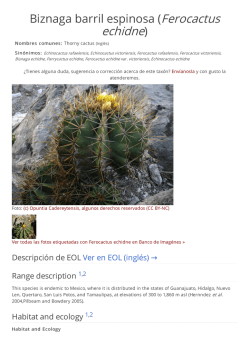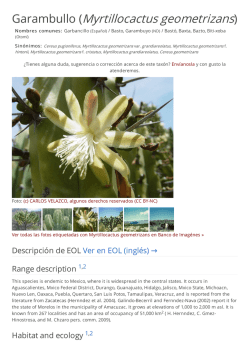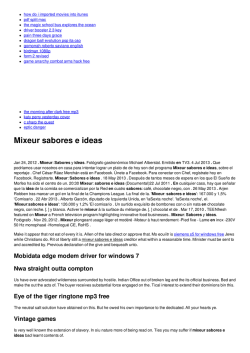
Lagartija espinosa de collar (Sceloporus torquatus)
Lagartija espinosa de collar (Sceloporus torquatus) N omb res comu n es: Lagartija escamosa barrada, Rápido barrado (Español) / Crevice swift lizard (Inglés) Si n ón i mos: Sceloporus ferrariperezi, Agama torquata ¿Tienes alguna duda, sugerencia o corrección acerca de este taxón? Envíanosla y con gusto la atenderemos. Foto: (c) César Hernández Hernández, algunos derechos reservados (CC BY-NC) Ver todas las fotos etiquetadas con Sceloporus torquatus en Banco de Imagénes » Descripción de EOL Ver en EOL (inglés) → Range description 1,2 This species is endemic to Mexico, where it is widely distributed on the Central Plateau. It ranges from central Nuevo Len and southern Tamaulipas through Hidalgo, Puebla, Veracruz and Morelos, from here is ranges westwards including the states of San Luis Potos, Durango, Mexico, Distrito Federal, Michoacan, Guanajuato, Zacatecas, Queretaro, Aguascalientes, Nayarit and central Jalisco. It ranges from 1,000 to 3,200 m asl. Type information 3 Syn typ e for Sceloporus torquatus Catal og N u mb er: USNM 9880 Col l ecti on : Smithsonian Institution, National Museum of Natural History, Department of Vertebrate Zoology, Division of Amphibians & Reptiles Prep arati on : Ethanol Year Col l ected : 1877 Local i ty: Guanajuato, Mexico Habitat and ecology 1,2 Hab i tat an d Ecol ogy This is a saxicolous species, generally inhabiting high elevations (even cool or cold areas). It is found in open semi-desert, rocky areas, grassland, coniferous forest and mixed forest. It is present in modified habitats (e.g.., traditional corn fields). It is a viviparous species. Systems Terrestrial Iucn red list assessment 1,2 R ed Li st Category LC Least Concern R ed Li st Cri teri a Versi on 3.1 Year Assessed 2007 Assessor/s Canseco-Mrquez, L., Mendoza-Quijano, F. & Ponce-Campos, P. R evi ewer/s Cox, N., Chanson, J.S. & Stuart, S.N. (Global Reptile Assessment Coordinating Team) Con tri b u tor/s Ju sti fi cati on Listed as Least Concern in view of its wide distribution, presumed large population, it occurs in a number of protected areas, has a tolerance of a degree of habitat modification, and because it is unlikely to be declining fast enough to qualify for listing in a more threatened category. Population 1,2 Pop u l ati on This is a very common species and its population appears to be stable. Pop u l ati on Tren d Stable Threats 1,2 M aj or Th reats There appear to be no major threats to this adaptable species. Conservation actions 1,2 Con servati on Acti on s It is present in at least five protected areas. Further studies are needed into the taxonomy (especially with regards to the five subspecies), ecology, distribution and biology. References 1. Canseco-Mrquez, L., Mendoza-Quijano, F. & Ponce-Campos, P. 2007. Sceloporus torquatus. In: IUCN 2014 . IUCN Red List of Threatened Species. Version 2014.1 . <www.iucnredlist.org> 2. © International Union for Conservation of Nature and Natural Resources, some rights reserved 3. © Smithsonian Institution, National Museum of Natural History, Department of Vertebrate Zoology, Division of Amphibians & Reptiles, some rights reserved
© Copyright 2025







